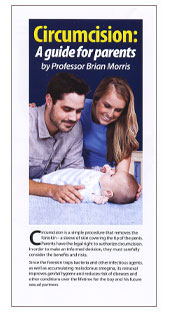Circumcision -
Sensitivity, Sensation and Sexual Function
Brief summary: High quality evidence from detailed systematic reviews of all studies [Morris & Krieger 2013, Tian et al., 2013; Shabanzadeh et al. 2016; Yang et al., 2018], meta-analyses [Tian et al., 2013; Yang et al., 2018], and randomized controlled trials [Kigozi et al., 2008; Krieger et al., 2008] has established conclusively that circumcision has no adverse effect on sexual function, sensitivity and sexual pleasure. The most recent systematic review [Yang et al., 2018] found 58% lower risk of erectile dysfunction in circumcised men and that circumcised men were 64% less likely to experience pain (dyspareunia) during intercourse. The systematic reviews were by authors in Australia and the US [Morris & Krieger, 2013], China [Tian et al. 2013; Yang et al. 2018] and Denmark [Shabanzadeh et al. 2016]. The randomized controlled trials were conducted in Africa [Kigozi et al., 2008; Krieger et al., 2008]. Trial data reported by Krieger et al. [2008] and Nordstrom et al [2017] found that most men reported increased sexual pleasure at the end of the trial. A similar finding was made in a large longitudinal study in Central America [Brito et al., 2017]. A large study conducted in the UK found the same [Homfray et al., 2015]. There is convincing biological support for this conclusion, as shown in a systematic review in Sexual Medicine [Cox et al. 2015]. Since the neuroreceptors responsible for sexual pleasure are concentrated in the head of the penis and the shaft, with none in the foreskin, it makes sense that circumcision does not reduce a man’s sexual pleasure [Cox et al., 2015]. Sexual problems are common in men. Men so affected may go to the Internet to discover what the cause might be. There they will quickly find fallacies by opponents of circumcision telling them that the cause is their infant circumcision. Men gullible enough to believe such myths are at risk of becoming angry with their parents’ decision for them as a baby and may fail to seek proper medical help [Bailis et al., 2019].
In what follows the progress over the years in understanding this topic is presented.
The foreskin contains sensory nerve receptors as are prevalent over the rest of the penis. There is no scientific evidence that the extra complement of these in uncircumcised men leads to greater sexual pleasure. In fact, some uncircumcised men have been known to complain that their penis is too sensitive, leading to pain, and seek circumcision to relieve this. Diminishing sensitivity is in fact desired by many men and women in order to prolong the sex act by preventing premature ejaculation [Burger & Guthrie, 1974]. But what is the truth? This section presents the research evidence upon which a valid conclusion can be reached.
Orgasm, the culmination of the sex act, is not related to the foreskin, and involves activity of neurones in the hypothalamus of the brain.
It should also be added that anecdotes cannot be accepted, and any hypothesis they might suggest must be tested by scientific research before receiving serious consideration. Fanciful speculation by anti-circumcision proponents must be disregarded, as should dubious publications involving biased study groups [O'Hara & O'Hara, 1999]. So let’s look at the scientific evidence.
Masters & Johnson undertook clinical and neurological testing of the ventral and dorsal surfaces, as well as the glans, and detected no difference in penile sensitivity between circumcised and uncircumcised men [Masters & Johnson, 1966]. Sexual pleasure also appears to be about the same.
Two US studies published in 2002 both found similar or greater sexual satisfaction in men after circumcision as adults [Collins et al., 2002; Fink et al., 2002]. The mean age of the men in each study was 37 and 42, respectively. In the smaller survey [Collins et al., 2002] there was no difference in sexual drive, erection, ejaculation, problem assessment or satisfaction compared with what the men recalled sex being like prior to foreskin removal. Penile sensitivity was the same.
The Collins paper stated that their study was prompted by reports by proponents of "foreskin restoration", in particular the "disparity between the mythology and medical reality of circumcision regarding male sexuality" [Collins et al., 2002].
In the Fink study of 123 men [Fink et al., 2002], 62% said they were satisfied with having been circumcised (they liked their new look) and 50% reported benefits. There was no change in sexual activity. Penile sensitivity, although not tested directly, was thought by some of the men in this study to be slightly lower (but not statistically so), which may have contributed to their claims of better sex. Although there was no change in sexual activity, some of the men thought erectile function was slightly less (category scores: 12.3 vs 11.1, P = 0.05), which is the opposite of the very much larger National Health and Social Life Survey [Laumann et al., 1997]. Fink and co-workers point out that this would, however, have to be confirmed by duplex Doppler ultrasound before a definitive conclusion could be made. Furthermore, the outcome of this study could have been affected by the fact that 93% of the men had been circumcised for a medical problem. Both the men and their partners preferred the appearance of the penis after it had been circumcised. As in other studies [Laumann et al., 1997] oral sex became more frequent, but there was no change in anal sex or masturbation [Fink et al., 2002]. Their partners were also more likely to initiate sex with them.
A report in 2004 of men circumcised for non-medical reasons in Turkey showed an increase in ejaculatory latency time, which may or may not reflect decreased sensitivity, but this was considered by the men as an advantage in that they could prolong intercourse [Senkul et al., 2004]. Another study, discussed below, found ejaculatory latency time was significantly lower in Turkish men compared with men in the USA, UK and European countries [Waldinger et al., 2005].
A US study involving a battery of quantitative somatosensory tests to evaluate the spectrum of small to large axon nerve fiber function found no difference in sensitivity of the glans penis between 43 uncircumcised and 36 neonatally circumcised men [Bleustein et al., 2005]. The authors controlled, moreover, for factors that can alter neurologic testing (age, erectile function status, diabetes, and hypertension).
A study of 150 men aged 18 to 60 circumcised for benign disease in London found identical erectile dysfunction scores before and after [Masood et al., 2005]. Of these 74% had no change in libido, 69% had less pain during intercourse (P < 0.05), 44% of the men (P = 0.04) and 38% of the partners (P = 0.02) thought appearance was better after circumcision. Sensation improved in 38% (P = 0.01), was unchanged in 44%, and was worse in 18%. Overall, 61% were pleased and 17% were not, i.e., 3.5 times more were happy with their circumcision.
In a study published in 2005 of 500 couples, intravaginal ejaculatory latency time (IELT; = time from start of vaginal intromission to start of intravaginal ejaculation, recorded by stopwatch and paper diary) was 6.7 minutes (range 0.7 to 44.1) in circumcised men, being not statistically longer than the time found in uncircumcised men of 6.0 minutes (range 0.5 to 37.4) [Waldinger et al., 2005]. These times were similar in the Netherlands, UK, Spain and the USA. Time to ejaculation in Turkey, however, (3.7 minutes; range 0.9-30.4) was significantly lower. Intravaginal ejaculatory latency time decreased significantly with age: in men aged 18-30 years, the time to ejaculation was 6.5 min, compared with 4.3 min in men over 51 years (P < 0.0001). The data were not affected by condom use.
This group of researchers then repeated the study using a blinded timer device (to reduce any bias) in a different set of 474 men (mean age 38.5 ± 11.4 SD) from the same countries, publishing the findings in 2009 [Waldinger et al., 2009]. In circumcised men (excluding Turkey) mean intravaginal ejaculatory latency time was 10.3 min (± 9.3 SD; range 0.6-52.7), and in uncircumcised men was 8.8 min (± 6.9 SD; range 0.3-38.6) (P = 0.13). Median was 7.2 and 6.0, respectively (excluding Turkey: 4.4 min). Alcohol users had a higher mean IELT than non-users (9.0 vs 7.3; P = 0.002). But there was no difference for condom users and nonusers (7.7 vs 9.0) nor age-group (8.2, 9.2 and 7.3 for 18-30, 31-50 and >51 years), and number of sexual events did not decrease with age category. Erectile dysfunction was 37%, 34% and 40% in the respective age categories. The men's own estimates of IELT were 31% higher than the actual recorded values. One-third had an IELT shorter than they would have liked (4.9 min) and two-thirds of these were willing to take medication to remedy this.
A study in Turkey found no relationship between age of childhood circumcision and overall sexual function in men aged 22-44 (mean 30) [Aydur et al., 2007]. Since all men are circumcised in this Muslim country there was no control group of uncircumcised men to compare with. Of seven areas of sexual function examined, the only difference was higher avoidance seen in those circumcised between ages 0-2 compared to the 3-5 and 6-12 age groups [Aydur et al., 2007]. Small sample size was another limitation of the study, and if a Bonferroni correction for multiple testing was carried out this single difference found could have been eliminated.
A randomized controlled trial in Uganda of 4,456 sexually-experienced men aged 15-49 found no difference in sexual satisfaction or clinically significant function between the 2,210 randomized to receive circumcision and the 2,246 who remained uncircumcised over the 2 years of the trial [Kigozi et al., 2008]. At 6 months (i.e., the earliest time examined after the procedure), difficulty with penetration was seen in 1.4% of circumcised men and 0.6% of uncircumcised men, pain on intercourse 0.6% of circumcised and 1.2% of uncircumcised men. And at 12 months and 24 months these were all identical between each group. Sexual satisfaction in circumcised men was 98.5% at enrollment and 98.4% at 2 years, and in uncircumcised men was 98.0% and 99.4% at these times, i.e., was not significantly different between the groups.
Data from another large randomized controlled trial, in Kisumu, Kenya, dispelled the myth that circumcision diminishes penile sensitivity. In fact 64% of the men in this trial reported an INCREASE in their penile sensitivity and 55% reported greater ease in reaching orgasm [Krieger et al., 2008]. This did not, however, mean an increase in premature ejaculation in these men. The fact that circumcision does not impair, and for many may enhance, a man's sensation and sexual pleasure, should reassure men considering whether to get circumcised [Sharlip, 2008].
An objective tool in assessment of sexual satisfaction is the measurement of penile pudendal evoked potentials (PEP), where sensory stimuli on the glans and penis are transmitted by the pudendal nerve. In men aged 18-27 years who underwent circumcision, mean PEP latency was 42.0 milliseconds before circumcison and 44.7 milliseconds after circumcision, the difference (2.76 milliseconds) being statistically significant [Senol et al., 2008]. The authors conclude that circumcision may contribute to sexual satisfaction by prolonging PEP latency by 5% and thus intercourse time. The study found, moreover, that sexual function was not adversely affected by circumcision.
Concerns about leaving too much mucosa during circumcision, for fear of later premature ejaculation (PE), appear unfounded. A study in Iran found mucosal cuff length was 15.4 mm in men with PE and 14.7 in men without PE, a difference that was not statistically significant [Hosseini et al., 2008]. In this study, penisx length was 121 mm and 130 mm in each respective group.
A study in the San Francisco Bay Area conducted by notable anti-circumcision activists and funded by NOCIRC measured "fine-touch pressure thresholds" at 19 locations on the uncircumcised and 11 on the circumcised penis [Sorrells et al., 2007]. Although the authors claimed that their study showed the glans of the uncircumcised penis to be more sensitive than the circumcised, this is false, as analysis of their data by Waskett & Morris showed there was in fact no statistical difference [Waskett & Morris, 2007]. Despite other claims, the actual statistics in the NOCIRC paper showed a marginally significant difference (P = 0.03) only for the orifice rim. However, their statistical analysis was naïve and incomplete.
When Waskett & Morris then conducted a Bonferroni correction on their data, as should have been done by the authors, in order to eliminate false positives arising from the multiple testing they carried out, this marginal statistical difference disappeared [Waskett & Morris, 2007]. Their data thus showed there was no difference in sensitivity between the circumcised and uncircumcised penis. Moreover, serious design flaws, subjects in the Methods who were unaccounted for in the data presented in their Results section, biased presentation, and other omissions make this study lack any credibility whatsoever [Waskett & Morris, 2007].
Sensation:
The MOST IMPORTANT issue is not the sensitivity of the flaccid penis, but the SENSATION of the penis experienced during arousal. The first study of arousal was conducted in Montreal using thermal imaging of the penis, and found no difference between circumcised and uncircumcised men aged 18-45 (mean age 24) [Payne et al., 2007a]. Sensation was assessed by measurement of surface skin temperature just below the glans adjacent to the coronal ridge on the lateral right surface of the penile shaft. Both penile temperature and touch thresholds were lower at baseline in the uncircumcised men, indicating lower sensitivity of the flaccid uncircumcised penis. More circumcised participants reported an increase in their level of arousal, while more uncircumcised men reported being unaffected by the erotic stimulus (movie). Sensitivity to touch on the forearm as compared to the glans penis or shaft decreased during arousal in both groups. A sex difference is apparent, since a similar study in women by the same research group found an increase in vulvar sensitivity during sexual arousal [Payne et al., 2007b].
Conclusion:
There is little or no difference in sensation during arousal or sensitivity of the flaccid penis between circumcised and uncircumcised men.



